The Best Plum Varieties and Trees to Grow in Your Garden
Published: September 13, 2025 at 11:00:00 PM UTC
Plum trees offer an incredible combination of beauty and bounty for home gardeners. These versatile fruit trees not only provide delicious, nutritious harvests but also enhance your landscape with stunning spring blossoms and attractive foliage. Growing your own plums allows you to enjoy varieties rarely found in stores, often with superior flavor and freshness. Plus, the spring flowers attract beneficial pollinators that help your entire garden thrive. Whether you have a spacious yard or a modest garden plot, there's a perfect plum variety waiting to transform your outdoor space into a productive paradise.
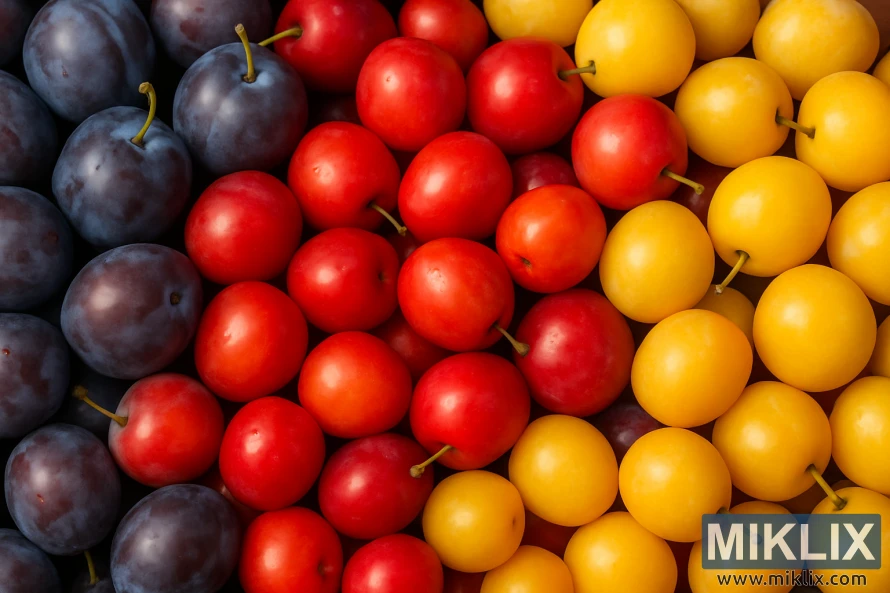
Choosing the Right Plum Tree for Your Garden
Selecting the perfect plum tree involves considering several key factors that will determine your success. The right choice depends on your specific growing conditions, available space, and personal preferences for fruit characteristics. Let's explore the essential considerations to help you make an informed decision.
Climate Considerations and Growing Zones
Plum trees are generally categorized into three main types: Japanese, European, and American native varieties. Each type has different climate requirements that directly impact their performance in your garden:
- Japanese plums (Prunus salicina) thrive in warmer climates (USDA zones 5-9) and typically bloom earlier in spring. They produce juicy, sweet fruits perfect for fresh eating but may be vulnerable to late frosts in colder regions.
- European plums (Prunus domestica) are more cold-hardy (zones 4-8) and better suited for northern gardens. They generally offer fruits that are excellent for drying, preserving, and cooking.
- American native plums (Prunus americana) are extremely hardy (zones 3-8) and adaptable to various soil conditions, making them ideal for challenging growing environments.
Before selecting a plum variety, check your USDA hardiness zone and consider your local microclimate, including factors like wind exposure, frost pockets, and summer heat intensity.
Space Requirements and Tree Size
Plum trees come in different sizes to accommodate various garden spaces:
- Standard trees reach 15-25 feet in height and spread, requiring about 18-20 feet of spacing between trees. These are ideal for larger properties where space isn't limited.
- Semi-dwarf trees grow to 12-15 feet tall and wide, needing approximately 12-15 feet of spacing. They offer a good balance of yield and manageable size for medium gardens.
- Dwarf plum trees typically reach only 8-10 feet in height and spread, requiring just 8-10 feet between trees. These compact varieties are perfect for small gardens, containers, or creating an accessible fruit hedge.
Consider not just the current state of your garden but how the space might change over the 15-20 year lifespan of your plum tree. Remember that proper pruning can help control size, but starting with the right-sized tree for your space is essential.

Pollination Requirements
Understanding pollination needs is crucial for ensuring your plum trees produce fruit:
- Self-fertile varieties can produce fruit on their own, making them ideal for small gardens where space limits you to a single tree. Many European plums fall into this category.
- Partially self-fertile varieties will set some fruit alone but produce much better harvests with a compatible pollinator nearby.
- Self-sterile varieties require cross-pollination from a different compatible variety to produce fruit. Most Japanese plums need cross-pollination.
For varieties requiring cross-pollination, plant compatible varieties within 50 feet of each other to ensure good fruit set. Different varieties must bloom at the same time for successful pollination.
Soil and Sunlight Requirements
Plum trees thrive under specific growing conditions:
- Soil: Well-draining, loamy soil with a pH between 5.5 and 6.5 is ideal. Heavy clay soils should be amended with organic matter to improve drainage, as plum trees are susceptible to root rot in waterlogged conditions.
- Sunlight: All plum varieties require full sun (at least 6-8 hours of direct sunlight daily) for optimal fruit production and disease resistance. Insufficient sunlight results in poor fruiting and increased susceptibility to pests and diseases.
- Water: Consistent moisture is important, especially during fruit development. However, the soil should never remain soggy.
Before planting, test your soil and make necessary amendments to create the optimal growing environment for your plum trees.
Top 7 Plum Varieties for Home Gardens
After analyzing dozens of plum varieties, we've selected the seven best options for home gardeners based on flavor, adaptability, disease resistance, and overall performance. These tried-and-true varieties offer excellent results across various growing conditions.
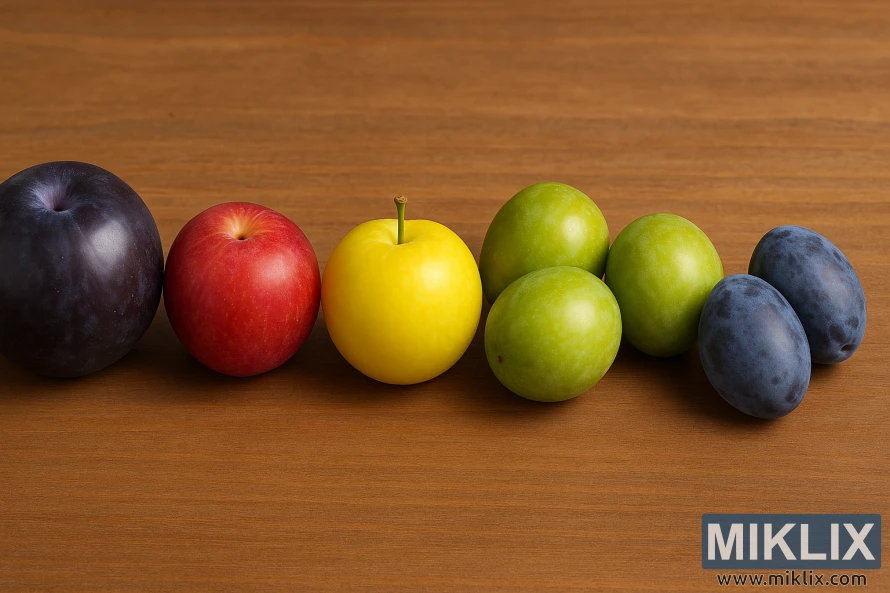
European Plum Varieties
European plums are prized for their rich flavor and versatility in cooking, baking, and preserving. These varieties typically have firmer flesh and higher sugar content, making them excellent for drying into prunes.
1. Stanley Plum
- Flavor Profile: Sweet with balanced tartness; rich and complex when fully ripe
- Best Growing Zones: 5-7, with good cold hardiness
- Harvest Period: Late August to early September
- Unique Characteristics: Self-fertile, excellent disease resistance, particularly to brown rot; versatile for fresh eating, cooking, canning, and drying
- Tree Size: Medium vigor, reaching 10-15 feet tall with proper pruning
The Stanley plum is one of the most reliable and productive varieties for home gardens. Its self-fertile nature means you'll get fruit even with just one tree, though yields improve with a pollinator nearby. The deep blue-purple fruits have yellow flesh that separates easily from the pit, making them perfect for processing. Stanley trees are known for their consistent production year after year, even in less-than-ideal conditions.
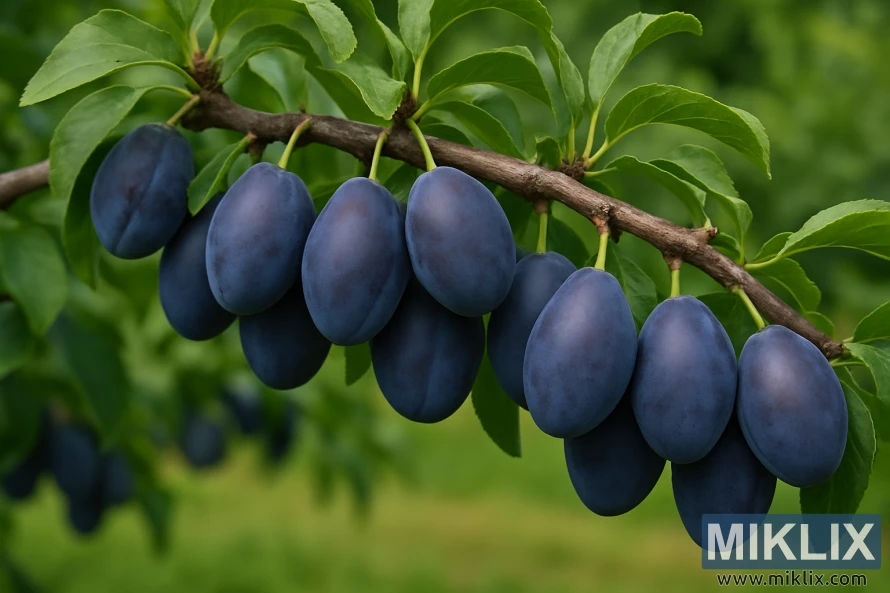
2. Green Gage Plum
- Flavor Profile: Exceptionally sweet and honey-like; often considered the best-tasting plum
- Best Growing Zones: 5-7
- Harvest Period: Mid to late August
- Unique Characteristics: Self-fertile, distinctive green-yellow fruit, historic heirloom variety dating back centuries
- Tree Size: Moderate growth, 12-15 feet tall
Green Gage plums are treasured for their incomparable sweetness and complex flavor that many describe as honey-like with floral notes. These greenish-yellow fruits may not look as impressive as purple varieties, but their flavor is unmatched. The trees are moderately vigorous and produce reliable crops in cooler climates. Green Gage plums are excellent for fresh eating and making preserves that showcase their exceptional flavor.

3. Damson Plum
- Flavor Profile: Intensely tart and astringent when raw; develops rich, complex flavor when cooked
- Best Growing Zones: 5-7, very cold hardy
- Harvest Period: Late August to September
- Unique Characteristics: Extremely disease resistant, historically used for preserves and liqueurs, self-fertile
- Tree Size: Compact and hardy, 10-15 feet tall
Damson plums aren't meant for fresh eating but transform magically when cooked into jams, preserves, and liqueurs. These small, oval fruits with deep blue-purple skin have been cultivated since ancient Roman times. The trees are exceptionally hardy and disease-resistant, often producing abundant crops with minimal care. If you enjoy making preserves or are interested in traditional fruit varieties, Damson plums are an excellent choice for your garden.

Japanese Plum Varieties
Japanese plums are generally larger, juicier, and more aromatic than European varieties. They're primarily grown for fresh eating and tend to have a more pronounced sweet-tart flavor balance.
4. Santa Rosa Plum
- Flavor Profile: Sweet with tangy undertones; aromatic with rich plum flavor
- Best Growing Zones: 5-9, performs well in warmer climates
- Harvest Period: Mid-June to early July in most regions
- Unique Characteristics: Partially self-fertile, beautiful reddish-purple skin, early ripening
- Tree Size: Vigorous growth, 15-20 feet tall if not pruned
The Santa Rosa plum is perhaps the most popular Japanese variety for home gardens, and for good reason. These beautiful reddish-purple fruits offer an excellent balance of sweetness and tanginess with a distinctive aromatic quality. The trees bloom early and produce fruit earlier than most varieties, extending your plum harvest season. While partially self-fertile, Santa Rosa benefits from cross-pollination with varieties like Methley or Burgundy for optimal fruit set.
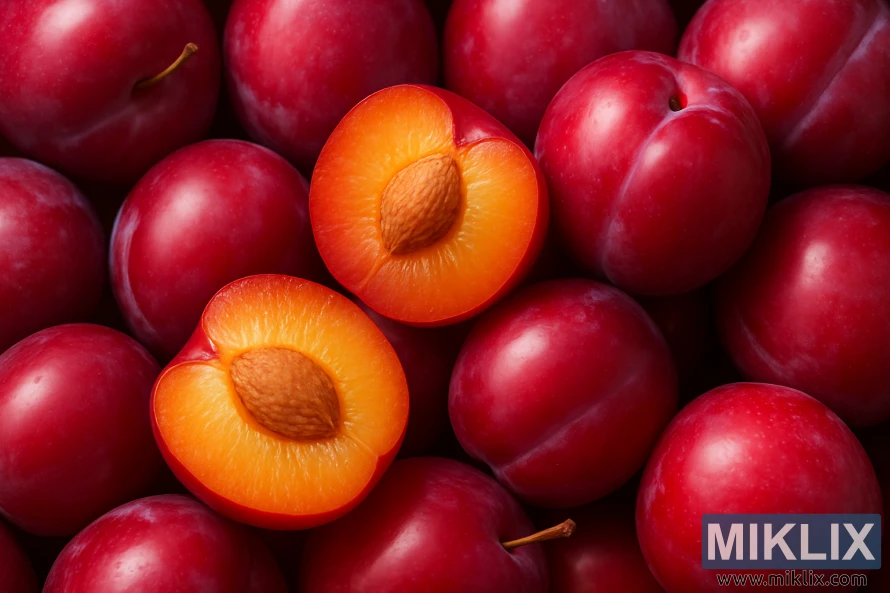
5. Methley Plum
- Flavor Profile: Sweet and mild with minimal acidity; juicy with red flesh
- Best Growing Zones: 5-9, adaptable to various climates
- Harvest Period: Very early, typically June
- Unique Characteristics: Self-fertile, extremely early ripening, beautiful red flesh, reliable producer
- Tree Size: Moderate vigor, 10-15 feet tall
Methley plums are prized for their reliability and early harvest, often providing the first plums of the season. These medium-sized fruits have reddish-purple skin and distinctive red flesh with a sweet, mild flavor that appeals to most palates. The self-fertile nature of Methley makes it an excellent choice for small gardens where space limits you to a single tree. These trees are also quite adaptable to different soil types and climate conditions, making them a safe bet for beginning fruit growers.
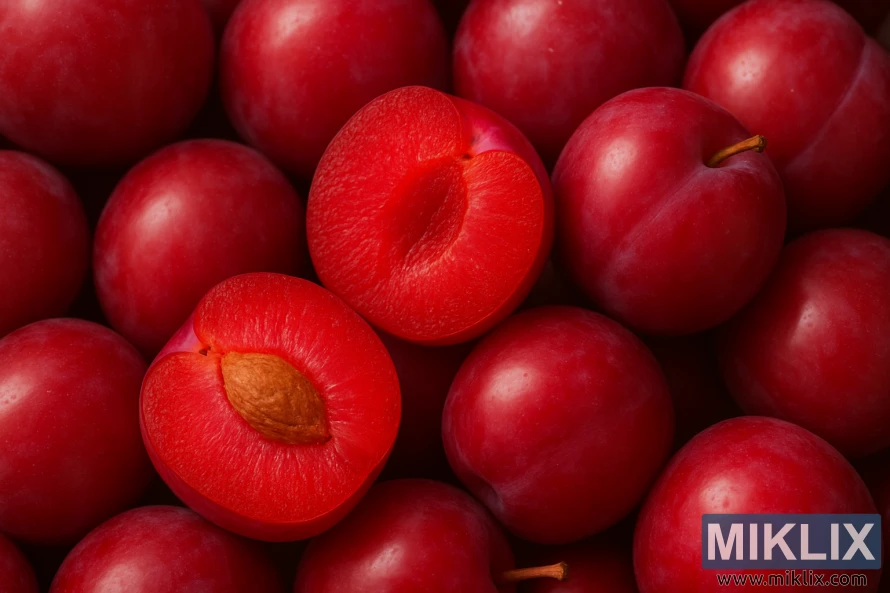
6. Satsuma Plum
- Flavor Profile: Sweet and rich with minimal acidity; distinctive red flesh
- Best Growing Zones: 5-9, good cold hardiness for a Japanese variety
- Harvest Period: Mid-July to early August
- Unique Characteristics: Beautiful dark red flesh, excellent for fresh eating and preserves, needs cross-pollination
- Tree Size: Moderate vigor, 12-15 feet tall
Satsuma plums are distinguished by their dark purple skin and striking red flesh that makes beautiful preserves and adds visual interest to fruit salads. The flavor is sweet and rich with very little acidity, making them popular for fresh eating. These trees require cross-pollination, so plant them near compatible varieties like Santa Rosa or Methley. Satsuma plums are moderately resistant to diseases and adapt well to various growing conditions, making them suitable for gardeners with some fruit-growing experience.
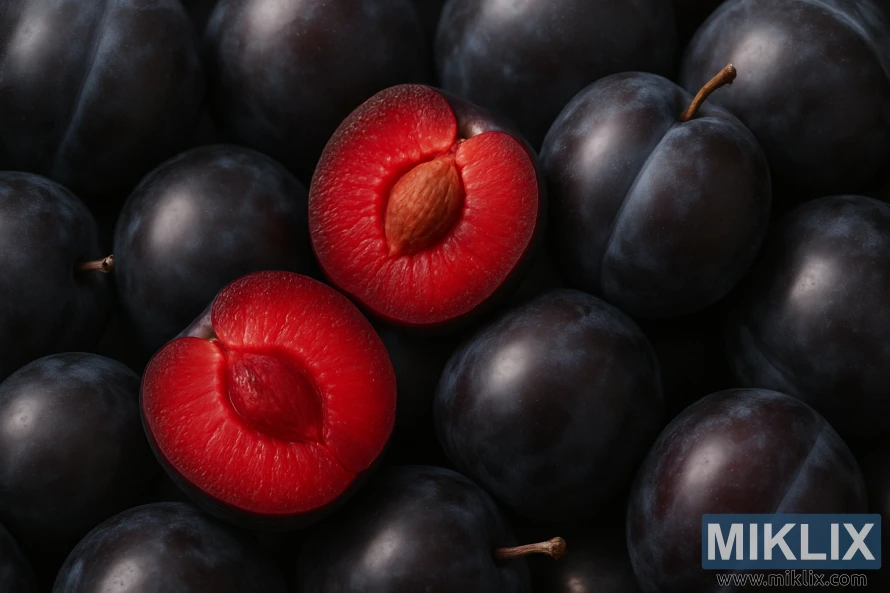
Hybrid Plum Variety
Hybrid plums combine characteristics from different plum species, often resulting in fruits with unique flavors and enhanced growing traits.
7. Superior Plum
- Flavor Profile: Sweet-tart balance; juicy with firm texture
- Best Growing Zones: 4-8, excellent cold hardiness
- Harvest Period: Late July to early August
- Unique Characteristics: Hybrid vigor, disease resistant, large attractive fruits, needs cross-pollination
- Tree Size: Moderate to vigorous growth, 15-18 feet tall
The Superior plum is a hybrid between Japanese and American native plums, combining the fruit quality of Japanese varieties with the cold hardiness of native plums. These large, bright red fruits offer excellent flavor and versatility for both fresh eating and processing. Superior plums require cross-pollination, so plant them with compatible varieties like Toka or Alderman. The trees show good resistance to common plum diseases and adapt well to challenging growing conditions, making them suitable for northern gardens where other Japanese varieties might struggle.
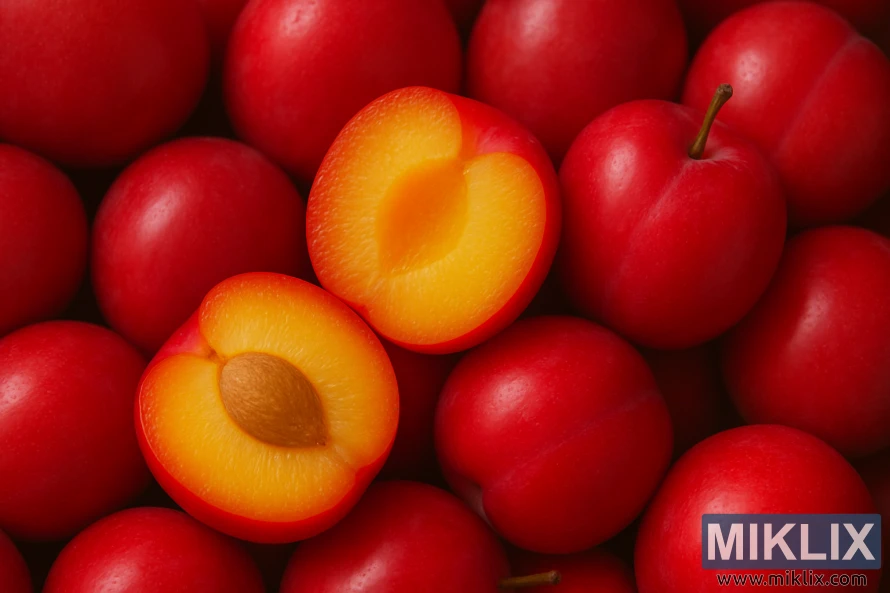
Planting and Care Tips for Plum Trees
Proper planting and ongoing care are essential for establishing healthy, productive plum trees in your home garden. Follow these guidelines to ensure your trees thrive and provide bountiful harvests for years to come.
Step-by-Step Planting Guide
- Timing: Plant bare-root trees in late winter or early spring while dormant. Container-grown trees can be planted throughout the growing season, though spring and fall are ideal.
- Site Selection: Choose a location with full sun (6-8 hours daily) and good air circulation. Avoid frost pockets and areas where water collects.
- Spacing: Allow 15-20 feet between standard trees, 12-15 feet for semi-dwarf, and 8-10 feet for dwarf varieties.
- Hole Preparation: Dig a hole twice as wide as the root spread but only as deep as the root ball. Create a small mound in the center to support the roots.
- Planting Depth: Position the tree so the graft union (visible swelling on the trunk) remains 2-3 inches above soil level. The root flare should be visible at the soil surface.
- Backfilling: Fill the hole with native soil, gently tamping to remove air pockets. Avoid adding fertilizer directly to the planting hole as it can burn young roots.
- Watering: Create a basin around the tree and water thoroughly, applying 2-3 gallons to settle the soil.
- Mulching: Apply 2-3 inches of organic mulch in a 3-foot circle around the tree, keeping it 3-4 inches away from the trunk to prevent rot.
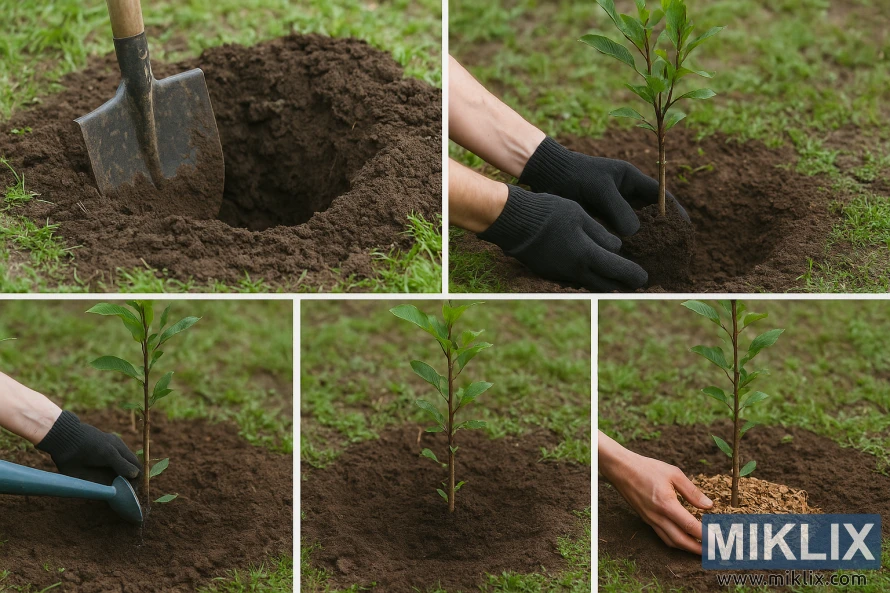
Pruning Techniques
Proper pruning is essential for plum tree health, fruit production, and disease prevention:
- Timing: Prune European plums in late winter while dormant. Japanese plums should be pruned in summer after fruiting to reduce the risk of silver leaf disease.
- Training System: Most home gardeners use an open center (vase) system for plums, which allows light penetration and easier harvesting.
- First Year: After planting, head back the main stem to 24-30 inches and select 3-4 well-spaced branches to form the main scaffold.
- Maintenance Pruning: Remove dead, diseased, or crossing branches annually. Thin out crowded areas to improve air circulation.
- Fruit Thinning: When fruits are marble-sized, thin them to one every 4-6 inches to improve size and quality.
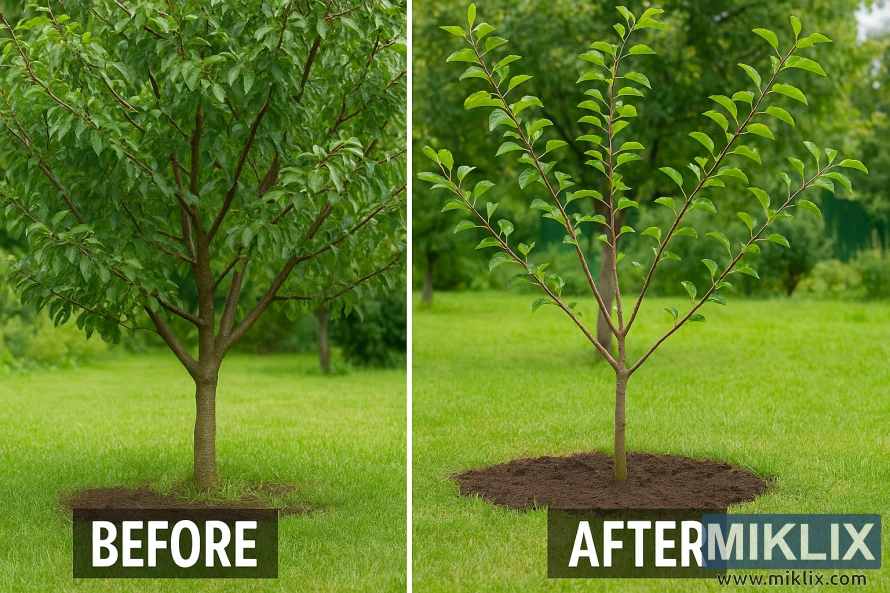
Watering and Fertilizing Schedule
Consistent moisture and proper nutrition are key to healthy plum trees and quality fruit:
- Young Trees (1-3 years): Water deeply once weekly, providing 5-10 gallons per tree. Increase frequency during hot, dry periods.
- Established Trees: Water every 10-14 days during dry periods, applying water slowly to allow deep penetration.
- First-Year Fertilizing: Apply a balanced fertilizer (10-10-10) in spring after growth begins, using 1/8 pound of actual nitrogen per year of tree age.
- Mature Tree Fertilizing: Apply 1 pound of actual nitrogen per year, split between early spring and early summer applications.
- Signs of Deficiency: Yellowing leaves may indicate nitrogen deficiency, while purple-tinged leaves suggest phosphorus deficiency.
Pest and Disease Management
Plum trees can face several challenges, but preventive measures help maintain tree health:
Common Pests:
- Plum Curculio: Small beetles that cause crescent-shaped scars on fruit. Control with organic sprays during petal fall.
- Aphids: Sap-sucking insects that distort leaves. Control with insecticidal soap or neem oil.
- Japanese Beetles: Feed on leaves and fruit. Hand-pick or use traps away from trees.
Common Diseases:
- Brown Rot: Fungal disease causing fruit rot. Remove affected fruit and prune for air circulation.
- Black Knot: Black growths on branches. Prune out infected areas in winter.
- Bacterial Leaf Spot: Causes holes in leaves. Apply copper-based sprays in early spring.
Integrated pest management practices like maintaining tree vigor, proper sanitation, and encouraging beneficial insects will help minimize problems without excessive chemical use.
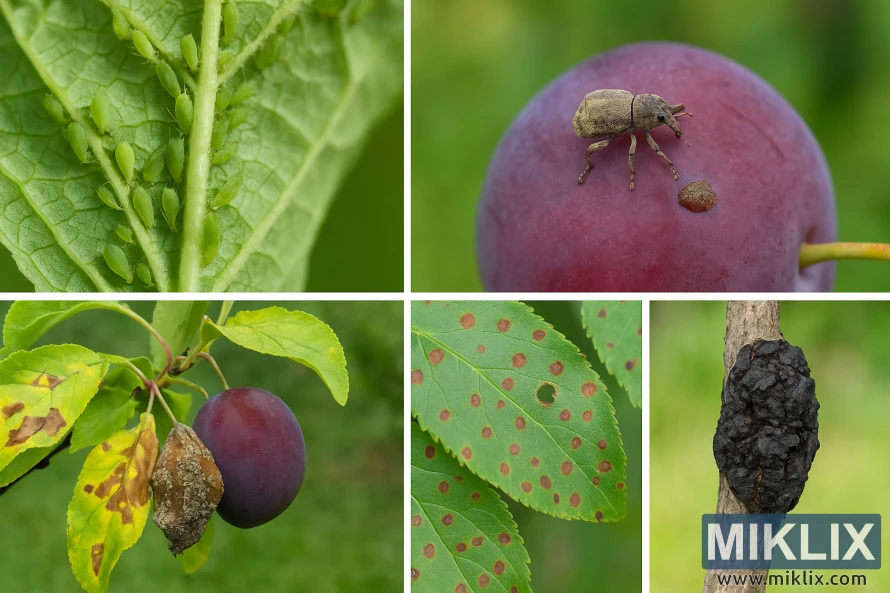
Frequently Asked Questions
How long until plum trees bear fruit?
Most plum trees begin bearing fruit 3-5 years after planting, depending on the variety and growing conditions. Dwarf varieties may produce fruit a year earlier than standard-sized trees. To encourage earlier fruiting, select trees grafted onto semi-dwarfing rootstocks and practice proper pruning techniques.
Can plum trees grow in containers?
Yes, dwarf plum varieties can thrive in containers, making them suitable for patios and small spaces. Choose a container at least 24 inches in diameter with good drainage. Use high-quality potting mix and ensure consistent watering, as container-grown trees dry out faster than those planted in the ground.
How do I know when plums are ripe and ready to harvest?
Ripe plums yield slightly to gentle pressure and have developed their full color (purple, red, yellow, or green depending on variety). They should detach easily from the tree with a slight twist. For best flavor, allow plums to ripen fully on the tree, but harvest before they become too soft.
Why did my plum tree bloom but not produce fruit?
Several factors can cause lack of fruit production: insufficient pollination (plant a compatible variety nearby), late frost damage to blossoms, improper pruning, pest or disease issues, or the tree being too young. Ensure adequate water during fruit development and proper pollination for consistent harvests.
Are plum trees difficult to maintain?
Plum trees are generally considered moderate in maintenance requirements. They need annual pruning, regular watering during dry periods, and some pest monitoring. However, once established, many varieties are quite resilient and can produce fruit with minimal intervention, especially disease-resistant varieties like Stanley and Methley.
Conclusion
Growing plum trees in your home garden offers tremendous rewards for relatively little effort. From the breathtaking spring blossoms to the sweet summer harvests, plum trees provide beauty, shade, and delicious fruit that far surpasses anything you'll find in grocery stores. By selecting varieties suited to your climate and space, and following the planting and care guidelines outlined above, you'll be well on your way to enjoying the pleasures of homegrown plums.
Whether you prefer the sweet, juicy Japanese varieties for fresh eating or the rich, complex European types for preserves and baking, there's a perfect plum tree waiting to enhance your garden. Start with one or two trees this season, and you'll soon discover why plums have been treasured in home gardens for centuries.
Further Reading
If you enjoyed this post, you may also like these suggestions:
- Growing Green Beans: A Complete Guide for Home Gardeners
- A Guide to Growing the Best Mangoes in Your Home Garden
- A Complete Guide to Growing Cauliflower in Your Home Garden
